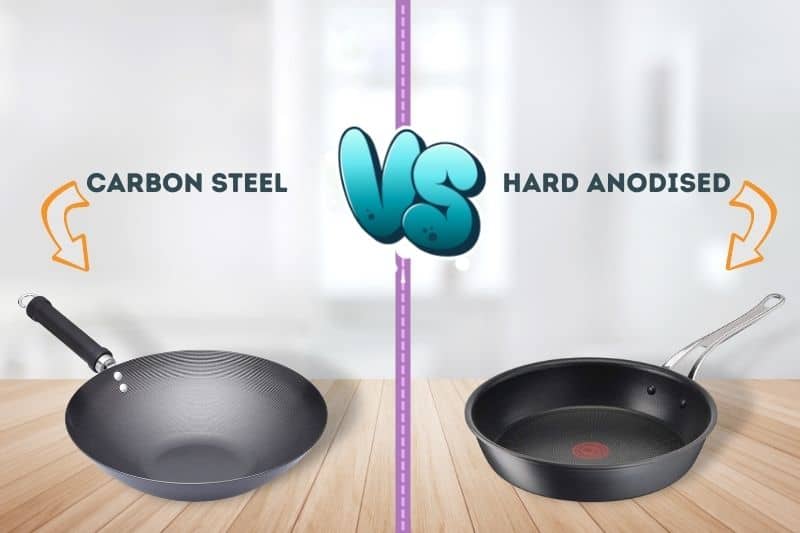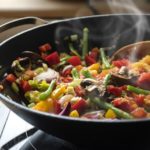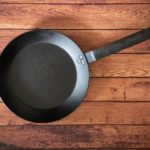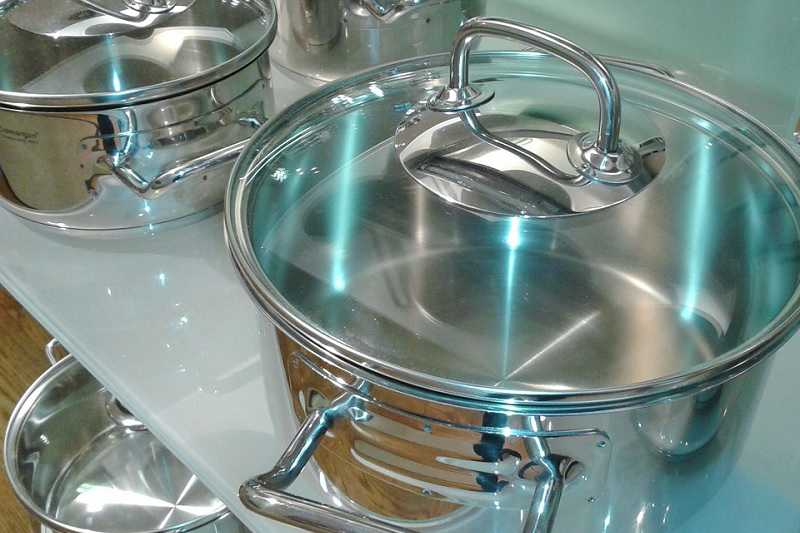You have likely heard of both carbon steel cookware and hard anodised cookware. Both are durable cookware options that make a great addition to any home kitchen.
But what are the differences between carbon steel vs hard anodised cookware? And which is the superior option for your home?
Here we look at the advantages and disadvantages of both of these emerging cookware options. This should help you decide which to purchase and what pan to use for your favourite recipe.
Pros and Cons of Hard Anodised Cookware
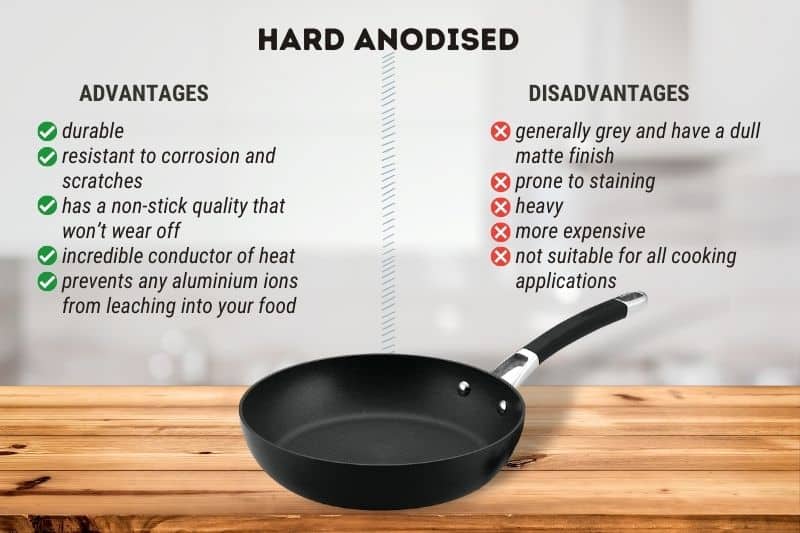
Hard anodised cookware refers to pots and pans made from aluminium.
However, unlike regular aluminium pans, hard anodised cookware has undergone a chemical treatment and has been exposed to an electrical current to produce an oxide. This oxide forms a thick layer on the surface of the pan, which carries both pros and cons.
Advantages of hard anodised cookware
One of the biggest advantages of hard anodised pots and pans is their durability. The layer of oxide on the surface of the pan strengthens the aluminium metal.
This means it is much less likely to become misshapen despite being used repeatedly at high temperatures.
It also makes the cookware resistant to corrosion and scratches. The oxide layer also provides a non-stick quality that won’t wear off. Therefore, these pans can last a lifetime!
The oxide coating also safely prevents any aluminium ions from leaching into your food. However, you still receive the benefits of cooking with this metal.
Aluminium is also known for being an incredible conductor of heat. This is extremely useful when it comes to cooking as the pans heat quickly and evenly.
This quality ensures you’re waiting less time for liquids to boil and means your food is cooked through perfectly every time.
Hard anodised cookware disadvantages
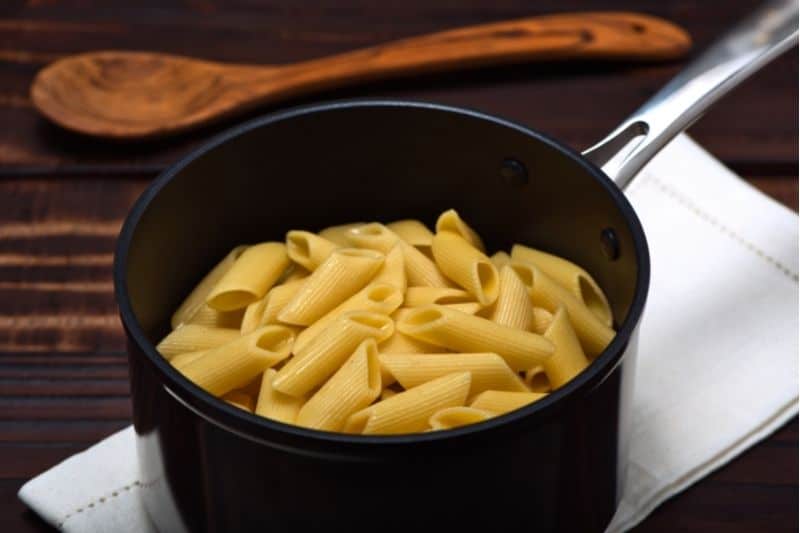
Unfortunately, hard anodised cookware isn’t the most sightly of cookware options. All these pans are generally grey and have a dull matte finish.
This is the colour of the oxide layer on the outside, and there isn’t much you can do to change its appearance.
Despite being durable, the exterior of the pan is also prone to staining as spills from cooking burn into the metal surface.
Hard anodised cookware is also heavy, and not a great option for anyone with weak wrists or a small kitchen.
They’re also more expensive than many other types of cookware. Plus, they’re not suitable for all cooking applications.
The oxide coating means these pans are not compatible with inductions hobs, nor can they be used in ovens heated to temperatures of more than 260°C.
Pros and Cons of Carbon Steel Cookware

Carbon steel pans are made from 99% iron and 1% carbon. This is the main difference between carbon steel vs hard anodised cookware, and the difference in material means these pans have entirely different properties.
Some of these are advantageous, while some are less favourable.
Advantages of carbon steel cookware
Carbon steel cookware is extremely lightweight and the perfect option for anyone that struggles to manoeuvre heavy cookware around the kitchen.
The material also has a smooth finish and therefore a natural non-stick quality as soon as the metal has been seasoned by burning off oil.
This makes it a great eco-friendly option as no chemicals were used to produce a non-stick coating.
Like hard anodised cookware, carbon steel is also extremely durable and designed to last forever. It can withstand extremely high heat and is safe for use in the oven or under a grill without fear of the metal warping shape.
As the non-stick properties are all-natural, these also won’t diminish over time as they do with regular non-stick pots. It’s also pretty affordable as far as cookware goes, and is one of the preferred pans used by many professional chefs.
Carbon steel cookware disadvantages
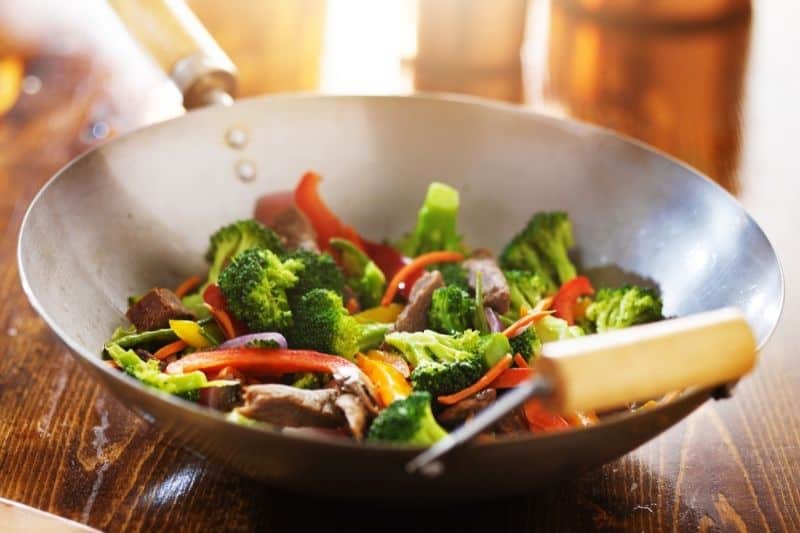
Unfortunately, like hard anodised cookware, carbon steel pans are not the prettiest kitchen addition. It has an unfinished quality and new pans are typically an uneven brown colour.
Made from almost 100% metal with no coating, this cookware is also prone to rust and should be dried immediately after washing.
You will also have to re-season the pan for it to regain its non-stick surface, making it a little more high-maintenance.
While the thinnest of carbon steel pans is beneficial in terms of weight, it does mean these pans don’t always eat evenly.
It can take a while for any of the metal not directly over the heat source to get warm. Additionally, iron is a reactive metal and ions will leach into your food when cooking acidic dishes.
Thankfully, we all need iron in our diet and many people are deficient, meaning this added boost of iron could be beneficial. Yet, it will make some food taste a little metallic.
Which Is Better – Carbon Steel or Hard Anodised Cookware?
The better choice – carbon steel vs hard anodised cookware – comes down to personal choice and what you’re cooking.
Both have many similarities; they are extremely durable, have natural non-stick properties, and don’t look the prettiest.
However, carbon steel pans are made without chemicals and are a more eco-friendly option, plus they’re extremely lightweight. Comparatively, hard anodised pans are very heavy.
The former is also better for cooking at high heat, whereas hard anodised pans are preferable for cooking any acidic dishes as no metal ions will leach into your food.
They also heat evenly for easier, more efficient cooking. However, hard anodised pans aren’t compatible with induction hobs, so avoid this cookware if you have an induction hob in your home.

Hannah is a freelance content writer and self-proclaimed foodie. When Hannah isn’t sitting tapping at her laptop, you’ll probably find her in the kitchen. As an ex-chalet host, she’s used to cooking four-course meals for 10+ people and loves feeding friends and family whenever possible.

